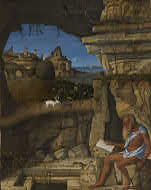
|
Giovanni Bellini (artist) Italian, c. 1430/1435 - 1516 Saint Jerome Reading, 1505 oil on panel painted surface: 47 x 37.5 cm (18 1/2 x 14 3/4 in.) support: 48.9 x 39.5 cm (19 1/4 x 15 9/16 in.) framed: 62.9 x 52.9 x 6 cm (24 3/4 x 20 13/16 x 2 3/8 in.) Samuel H. Kress Collection 1939.1.217 |
Object 4 of 7
Saint Jerome is often depicted on small devotional panels such as this one. During the Renaissance, the saint was favored by humanists because he had translated the Bible into Latin. His birth in an area then controlled by Venice made him especially popular with Venetian patrons. In the Gallery's collection are images of Jerome by other Venetian artists. The saint is often placed in the wilderness, where he had retreated as a hermit. In fact, the wilderness commands center stage. In Bellini's painting the saint and his lion occupy only a small area. The rocky strata seem equally alive, animated by a radiant light that suggests the divine. Many of the plants and animals have symbolic meanings -- rabbits, for example, serve as reminders of lust -- but Bellini treats them with the attention of a naturalist.
Perhaps, paradoxically, it was because Venice was so intensely urban that its artists developed into such evocative landscape painters. Their approach, in contrast to their contemporaries elsewhere, was more intuitive than scientific: they responsed to nature more than they accurately recorded it. Here, Bellini shifted the perspective three times -- we seem to look down on the saint and foreground, up at the looming rock face, and straight ahead into the distance.
| « | back to gallery | » | continue tour |


